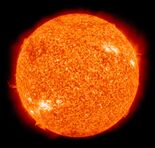Astronomy:Magnetic cloud
A magnetic cloud is a transient event observed in the solar wind. It was defined in 1981 by Burlaga et al. 1981 as a region of enhanced magnetic field strength, smooth rotation of the magnetic field vector, and low proton temperature.[1] Magnetic clouds are a possible manifestation of a coronal mass ejection (CME). The association between CMEs and magnetic clouds was made by Burlaga et al. in 1982 when a magnetic cloud was observed by Helios-1 two days after being observed by SMM.[2] However, because observations near Earth are usually done by a single spacecraft, many CMEs are not seen as being associated with magnetic clouds. The typical structure observed for a fast CME by a satellite such as ACE is a fast-mode shock wave followed by a dense (and hot) sheath of plasma (the downstream region of the shock) and a magnetic cloud.
Other characteristics
Other signatures of magnetic clouds are now used in addition to the one described above: among other, bidirectional superthermal electrons, unusual charge state or abundance of iron, helium, carbon, and/or oxygen.
The typical time for a magnetic cloud to move past a satellite at the L1 point is 1 day corresponding to a radius of 0.15 AU with a typical speed of 450 km/s (280 mi/s) and magnetic field strength of 20 nT.[3]
Other types of ejecta observed at Earth
Magnetic clouds represent about one third of ejecta observed by satellites at Earth. Other types of ejecta are multiple-magnetic cloud events (a single structure with multiple subclouds distinguishable)[4][5] and complex ejecta, which can be the result of the interaction of multiple CMEs.
See also
- List of solar storms
- Coronal cloud
- Interplanetary magnetic field (IMF) and Earth's magnetic field (magnetosphere)
- Space weather and heliophysics
References
- ↑ Burlaga, L. F., E. Sittler, F. Mariani, and R. Schwenn, "Magnetic loop behind an interplanetary shock: Voyager, Helios and IMP-8 observations" in "Journal of Geophysical Research", 86, 6673, 1981
- ↑ Burlaga, L. F. et al., "A magnetic cloud and a coronal mass ejection" in "Geophysical Research Letter"s, 9, 1317-1320, 1982
- ↑ Lepping, R. P. et al. "Magnetic field structure of interplanetary magnetic clouds at 1 AU" in "Journal of Geophysical Research", 95, 11957-11965, 1990
- ↑ Wang, Y. M., et al., Multiple magnetic clouds in interplanetary space, Solar Physics, 211, 333-344, 2002.
- ↑ Wang, Y. M., et al., Multiple magnetic clouds: Several examples during March - April, 2001, J. Geophys. Res., 108(A10), 1370, 2003.
External links


